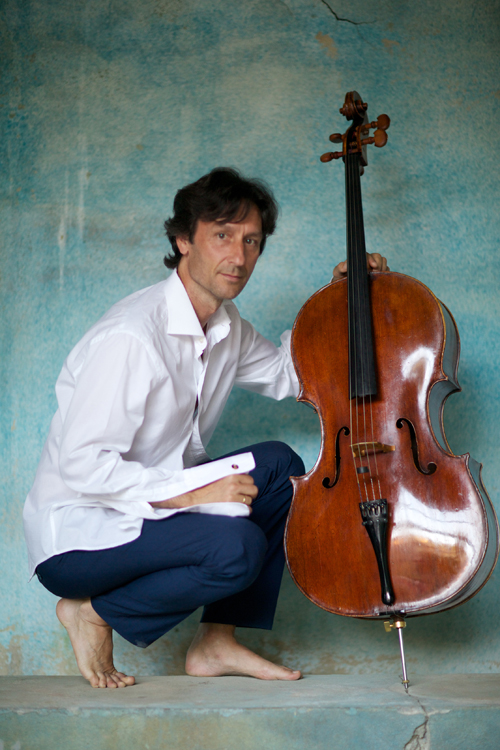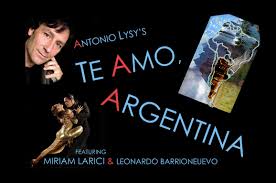Te Amo, Argentina cellist
Antonio Lysy (photo by Paul Flanagan
“I realized that Yehudi Menuhin was constantly in the midst of a never-ending musical journey, like a curious child making new discoveries at every turn.”
Antonio Lysy’s career as cellist and teacher is a tale of many countries and influences, particularly Quebec, Canada, Italy, Argentina and the US. He has performed internationally at leading venues such as Amsterdam’s Concertgebouw, with orchestras including the Zurich Tonhalle, Royal Philharmonic, Montreal and Toronto symphonies and collaborated with renown musicians such as Charles Dutoit, Yuri Temirkanov, Yehudi Menuhin, Vladimir Ashkenazy and Pascal Roge. Lysy is equally at home with a variety of repertoire that includes solo and chamber music works of Schubert, Beethoven, Berio, Walton, Henze and Bach – of which he has performed this composer’s six suites BWV 1007 to BWV 1012 on a classical and carbon fiber cello.
He is the impetus behind the acclaimed multimedia show Te Amo, Argentina, that features the sights and sounds of this country’s culture through musicians, tango dancers and compositions of Ginastera and Piazzolla. Lysy is a participant of the Piatigorsky International Cello Festival at the University of Southern California and Artistic Director of Incontri in Terra di Siena Chamber Music Festival in Tuscany, Italy. He was a former faculty member of McGill University in Montreal, the International Menuhin Music Academy in Gstaad, Switzerland and is currently Area Head of Strings at the University of California Los Angeles Herb Alpert School of Music. His recordings include Antonio Lysy at The Broad and Eric Zeisl’s cello concerto (Yarlung Records). Antonio Lysy sheds light about his studies, Argentine music and the concept of sound with Editor Leonne Lewis.
Your father Alberto Lysy was a distinguished Argentine violinist who studied with Yehudi Menuhin. Could you share some personal insights about Menuhin?
My father, Alberto Lysy, who passed away seven years ago, was I believe Yehudi Menuhin’s first real student. In fact, he was practically an adopted family member. He soon became Yehudi’s protégé, chamber music partner, colleague and collaborator, and that special relationship remained until Yehudi passed away. As a result, my own contact with Menuhin was extensive, having attended his schools in England (The Yehudi Menuhin School) and Switzerland (International Menuhin Music Academy) and later on having the privilege of performing with him on several occasions – as a chamber music partner, accompanying him in string ensembles and as soloist with him conducting. All in all, this spanned over twenty-five years.
Did your association with Yehudi Menuhin change your musical outlook?
Menuhin was a colossal influence on me and remains so to this day. He stood for so many things I admire: artistry, virtuosity, philosophy of life, vision, generosity towards other artists - especially young musicians. And also the dedication, depth and humility towards the music he performed combined with his unbelievable tenacity in the face of physical difficulties. He became for me a model of those rare musicians who amalgamate mind, body and soul at the highest echelons.
Could you share some of the things you learned from Menuhin’s teaching?
The lessons I learned from being in close contact with him for so many years were numerous and invaluable. One example was the unforgettable opportunities of performing Bach’s violin concertos with him. I had the chance to be leading the cello section, which provides the bass line or the continuo. It also has occasional solos with the violin. In these concertos, the continuo part often sets the tempo and the movement’s character, therefore holding a great deal of responsibility.
Yehudi wanted this underpinning line to inspire him at all times, in its rhythmic enunciation, molding of the phrase, and long-term vision to help motivate the highest potential for the solo line.
Was Menuhin’s approach to teaching user-friendly?
Menuhin was extremely demanding and with our performance of Bach’s violin concertos, he would spend the necessary time to construct and shape our notes, singing often and gesturing until it felt just right. It was never an analytical or prefabricated approach, which made guessing what he wanted difficult at times. He wanted us to understand the concept of the phrase, from every angle, to perceive his instinctive emotional drive, and then have us make it our own. But the greatest lesson was in returning to the same concerto a year later and going through the whole process again with what seemed to us completely new ideas. I realized that Menuhin was constantly in the midst of a never-ending musical journey, like a curious child making new discoveries at every turn. It was his philosophy to keep ideas fresh for himself and those he communicated with. He enthusiastically encouraged experimentation and saw those new ideas through with great conviction.
What were some impressions of your studies with William Pleeth?
My two years of study with William Pleeth, after Maurice Gendron’s influence, was quite a contrast to deal with, at age fourteen. Here was a man with a stellar teaching reputation (Jacqueline du Pre was among his students), but with a very different teaching style. I remember Pleeth as someone who really spoke to me with ideas I would understand through his music making – without him really ever playing a note. Gendron was just the opposite, as he played constantly for you to hear how it should sound and try to emulate. Occasionally Pleeth would demonstrate standing up, generally not caring what sound was actually being produced. But his sheer enthusiasm, colorful descriptions and eloquence in finding analogies were always extremely inspiring. Studying under him was sometimes confusing, as his pedagogy was designed to give great freedom and independence to each student, of thought and expression, and technique was seen as an end to itself.
Could you provide some examples of Pleeth’s teaching style?
As a young teenager I knew I needed a disciplined method to follow, but boy did I hate practicing with that clear-headed technical dogma in mind. Pleeth made it all fun, a journey of discovery and without pressure. An example of this occurred one day at a lesson where he taught with a mission to lift the fingers off the fingerboard as often as possible, to liberate the vibrato and limit any stiffness. I can still see and hear him, throwing his head and mop of hair eccentrically backwards and saying, “Yes! Liberate the fingers, free the hand, let go of the thumb if you want. Yes, like that! Now you are allowing the music to take flight!” It did sound much better and he was pleased at my result. In my next practice session I attempted that new technique but within a few days lost all control of my positions. I tried to return to the sensations and inspiration achieved in lessons under his enthusiastic guidance, but mostly fell short. Had I been seeing him weekly rather than monthly – not enough for an unschooled fourteen-year-old - he could have monitored these fluctuations, in spite of my weekly lessons with the patient and dedicated Myra Chahin. Through trial and effort, talent, past instruction, determination, positive competition with peers and pressure to perform in concerts, I eventually found my own way. In hindsight, when I consult Pleeth’s book Cello, (Yehudi Menuhin Music Guides, 1982), I can better understand what he was saying.
What makes Argentine music so attractive to musicians and audiences?
In my show, Te Amo, Argentina, three different cultures are heard, that are considered authentic Argentine music. They emanate from diverse geographical areas, as Argentina is a very large and long country that descends more or less from the Tropic of Capricorn to the South Pole. Of these: one is the South American Indian (Quechua) influence from the North; another is the Gaucho (cowboy), one of the national symbols, in the Pampas region; the last one is the capital city of Buenos Aires, with its unique and ever popular tango, in all its forms. They all share the essential aspect of a marked rhythmic sense, which forms the basis of their communicative power. It may be a drum beat, or horse's hooves, or a shuffling dance shoe, that we hear the influence of, stimulating the infectious pulse.
Has the Argentinean style influenced your cello playing?
I have enjoyed immensely getting to know these styles, connecting with my heritage and bringing them together in the show. Having the benefit of the great tango dancers Miriam Larici and Leonardo Barrionuevo dancing alongside me has been incredibly inspiring and motivated a completely different approach to the way I play the cello – in particular, the sounds I want to produce.
Speaking of sound production, how do you describe it and teach it to students?
Throughout my studies, I was exposed to many types, or schools of tone concepts, and taught different ways of producing them. I started with Maurice Gendron, a French virtuoso, who exemplified the silvery, lucid, perfumed and vibrant French sound. Then there was Radu Aldulescu, a Romanian artist of the highest order with his elegant, warm, distinguished and expressive sound. I closed my formal cello studies with Ralph Kirshbaum, the American maestro who is known for his rich, resonant, expansive, intense and penetrating tone – expressed through his gorgeous Montagnana cello.
So what does sound mean to you?
It is not straight forward to understand what sound really is, how it varies under different conditions and what will ultimately be the most satisfying and effective type to express oneself at any given moment – not just with contrasting styles that require a distinct approach but on different instruments, from my old friend the Tononi I have played on for thirty years, to a Baroque cello with gut strings, an electric Yamaha bodiless cello and even carbon fiber cello. We each have a basic sound that is intrinsic to our physical make up, which becomes apparent as soon as we put bow to string and place a finger on the string to stop it. Some have a strong instinctive sense of sound, others less so. Some have an acute sense of hearing the different shades of sound and others a poor one. This is all comparable to the other senses of taste, sight, smell and touch. We have layers on which to build.
Is sound then an intangible concept that really can’t be taught?
My sound has been called elegant and refined, no matter what I play and however hard I try to rough it up! Finding one’s own sound is in itself an intricate process that takes years of practice and experimentation. It is imperative to take that time though, as the music’s life and communicative powers will be reliant on this understanding. Sounds are perceived, even clearly identified by the ear but not labeled in the same way or detail. The poetic adjectives and moods we use to try to describe them are all we have, unless some mathematical wave-length, or decibel meter means something to us.
This is probably a good thing, for sound to preserve its unique magical qualities. The process therefore ends up being an intense individual research, to increase our palette of sound colors and then use them imaginatively and convincingly to express ourselves on the instrument. www.antoniolysy.com
CLICK THE LINK TO READ ABOUT ANTONIO LYSY’S CONCERTS



